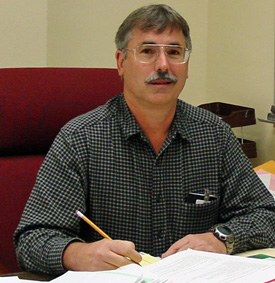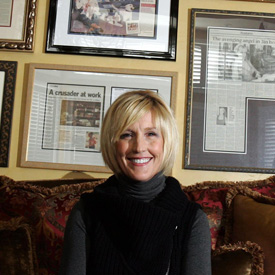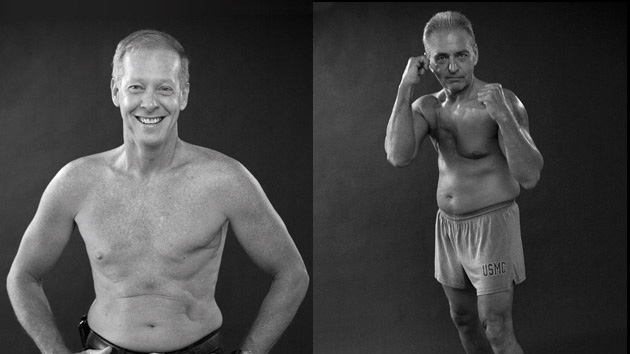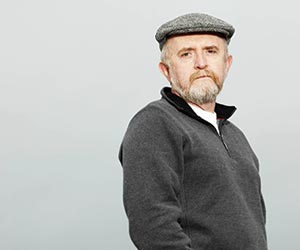
Julia Roberts in Erin Brockovich. John Morgan says the Oscar-winning 2000 movie was honored "in spite of the absence of evidence of a cancer excess in Hinkley."Jersey Films/Entertainment Pictures/ZUMAPRESS.com
This article was originally published by the Center for Public Integrity.
Even before the film Erin Brockovich depicted the true-life plight of a California town with poisoned water, state scientist John Morgan was calling claims of a cancer cluster there pure fiction.
For the past 18 years, the Loma Linda University professor, who also works as an epidemiologist for the California Department of Public Health, has tenaciously tried to debunk the notion that families in the desert community of Hinkley were suffering from a high rate of cancer after Pacific Gas & Electric dumped tons of a contaminant into an unlined wastewater pond.
Morgan has kept his research up to date and even today presents it at scientific conferences. His message is not subtle. At a conference in Maryland last year, he popped up one slide comparing Brockovich to a delusional Don Quixote and another mocking the Academy Awards for honoring the film “in spite of the absence of evidence of a cancer excess in Hinkley.”
Morgan doesn’t hide his disapproval of a recent ruling by the California Environmental Protection Agency that drinking hexavalent chromium, the rust inhibitor that PG&E dumped in Hinkley, can cause cancer. The agency based its ruling on rodent studies, but as Morgan says, “We’re not big rats.”
The Environmental Protection Agency has reached the same conclusion internally as California’s EPA—that drinking chromium causes cancer—but it faces powerful opposition from the chemical industry in making its ruling official. At stake is whether regulators will set stricter limits on how much chromium is allowed in drinking water. Tens of millions of Americans drink small amounts of chromium each day in their tap water.
The ongoing controversy has resurrected interest in Morgan’s work. Some writers and scientists cite it as proof that Brockovich was wrong.
But a review by the Center for Public Integrity found glaring weaknesses in Morgan’s analysis that challenge the validity of his findings. In his first study, he dismisses what others see as a genuine cancer cluster in Hinkley. In his latest analysis, he excludes people who were exposed to the worst contamination.
Morgan has done other questionable work. As an advisor to the American Council on Science and Health, which gets funding from the chemical industry, Morgan is featured on the group’s website, Riskometer.org. He claims that exposure to a number of toxic chemicals, including known carcinogens such as dioxins and hexavalent chromium, has killed no one from cancer in America.
Morgan stands by his research. He says he was dispelling a misconception fostered by the lawsuit and film that the entire community of Hinkley suffered from a high rate of cancer because of the pollution.
“This guy has got a bias”
In his Hinkley analysis, Morgan fails to distinguish residents who were exposed to heavy doses of chromium from those who were exposed to little or none at all. With any carcinogen, the more you’re exposed to it, the higher your odds of getting cancer as a result.
Morgan tallies all cancers among roughly 3,500 people in a 137-square-mile census tract. Yet the families who sued PG&E at Brockovich’s urging lived in a neighborhood of 13 homes covering roughly one square mile. Those families were exposed to chromium levels up to hundreds of times higher than anyone else in Hinkley.
Despite obvious limitations, local and state health officials often do this sort of back-of-the-envelope calculation when people complain about too many cancers in a neighborhood. Still, some epidemiologists say such analysis is weak science.
Other problems in Morgan’s work are not so common. In his first analysis from 1988 to 1993, Morgan actually found the cancer rate in Hinkley was 25 percent higher than in the surrounding counties. But he dismisses this cluster as a statistical mirage, a mere fluke.
Other epidemiologists who looked at Morgan’s numbers at the Center’s request disagree. Statistically, there’s at least 95 percent certainty that the cluster is not a fluke, said Richard Clapp, a Boston University professor who used to direct the Massachusetts Cancer Registry. He said that’s the statistical standard most epidemiologists use.
In his 2011 update, Morgan reports fewer cancers than expected in Hinkley. But he starts counting cancers in 1996, coincidentally the year PG&E settled the Brockovich lawsuit.
By then, PG&E had bought and bulldozed every home in the neighborhood where it had dumped chromium. All the people who had sued and were portrayed in the film had moved. One of them, Roberta Walker, said only a couple of families stayed in Hinkley. So, hardly anyone exposed to high levels of chromium are in the Morgan analysis most often cited.
“It seems to me that what’s going on here is this guy has got a bias. He’s trying to use his science to confirm his opinion,” said Stephen Lester, science director for the Center for Health, Environment & Justice, a group that helps communities with environmental problems.
Morgan defended his analysis, saying that he wasn’t testing whether chromium was safe to drink. He acknowledges that he has no data on who was exposed and by how much. But he said there was a popular notion that people in Hinkley were suffering from a high rate of cancer, and his analysis proves that was not true.
But what about the cancer cluster that other epidemiologists discovered in his first analysis? Morgan acknowledged that a 95 percent confidence interval is the standard most epidemiologists use. But he said the guidelines for the California Cancer Registry—guidelines he helped craft—call for 99 percent certainty. The cancer cluster in Hinkley didn’t reach that bar.
Morgan himself isn’t consistent in his use of the standard. He says the real problem in Hinkley is a cluster of cervical cancers as a result of women not getting Pap smears. But Morgan relies on a 95 percent confidence interval to deem that cluster statistically significant.
He justifies switching to a lower standard by saying his most recent research was done in his role as a college professor, not a state epidemiologist, so he didn’t have to adhere to state guidelines. In other words, the job Morgan is working determines whether a cancer cluster is real.
He struggled to explain why he started his latest Hinkley analysis in 1996, saying demographics change from one census to the next and for that reason it may be impossible to do a study over more than a decade. Morgan’s latest study stretches over 12 years, but he says he was pushing it by looking at such a long period of time.
Clapp said it is possible to do studies spanning more than a decade, and there are ways to adjust for changing demographics.
Morgan knows the neighborhood portrayed in the film was gone by 1996. He also knows that levels of chromium in most of the water in Hinkley are not much higher than is found naturally in the Mojave Desert. But again, he said it didn’t matter to him whether people in his study were exposed to chromium. He wasn’t looking into chromium exposure, he said; he was addressing the misconception that there was a cancer cluster in Hinkley.
Morgan speculated that people in Hinkley may be exposed to less chromium than others because he doesn’t believe they had been drinking the water since the film came out. In a visit in 2000, he noticed everyone had switched to bottled water. If he’s right, Morgan is left counting cancers in a town where an unknown number of people drank small traces of chromium many years ago.
Surprised by being asked about his analysis, Morgan said, “Now, what I presumed was you’re going after Erin Brockovich.”
Diluting a cancer studyAn often-cited study by researcher John Morgan found no cancer cluster in Hinkley, California. But the study looked for cancers throughout a census tract stretching over 137 square miles. The neighborhood contaminated with high levels of hexavalent chromium covered only one square mile. The red area shows where water wells exceeded state standards for chromium. Former residents of 13 homes there sued PG&E and were featured in the film Erin Brockovich. PG&E bought and destroyed these homes by early 1993. The blue area shows the census tract used in the study. Most of the people living there were exposed only to low levels of chromium that are naturally found in this part of the Mojave Desert. |
the Limits of epidemiology
Whether anyone in Hinkley got cancer from drinking chromium is an obvious question to ask. But science may not be able to answer it. Epidemiologists must rely on statistics, which aren’t capable of detecting whether a few extra people in a community got cancer from exposure to a toxic chemical. Either the chemical has to be really deadly, or the number of people in the study has to be very large. Epidemiologists sum it up this way: If they can detect a problem, you know you have a true catastrophe.
Morgan’s analysis illustrates the scientific limitations the EPA grapples with whenever it evaluates a toxic chemical.
The boundaries of the groundwater polluted by PG&E are now drawn around wells in Hinkley with more than naturally occurring levels of hexavalent chromium. The Lahontan Regional Water Quality Control Board currently defines that as 3.1 parts per billion—equal to about a tablespoon of chromium in an Olympic-size swimming pool.
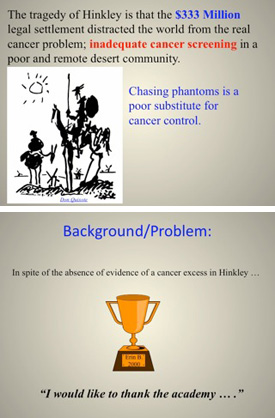
Only 18 homes had private wells exceeding that level in recent years, according to Lauri Kemper, the board’s assistant executive officer. Based on the state’s estimate of risk, if a group of 6,500 people drank that much chromium every day, you might see one cancer caused by it. One additional cancer in 6,500 won’t show up in Morgan’s study of 3,500 people, even if everybody drank the most polluted water.
As is often the case, there simply aren’t enough people to do a study. Even if there were hundreds of thousands of people drinking low levels of chromium, gathering data on how much chromium is in each person’s well is a daunting and expensive task.
The families portrayed in the movie are a different matter. One well near where Roberta Walker used to live still reads 1,500 parts per billion, despite years of cleanup. That’s nearly 500 times more chromium than anyone in Hinkley is exposed to today. At that dose, a person’s risk of getting cancer increases—theoretically, at least—by 1 in 13.
The lawyers Brockovich worked for tracked down 650 people who lived in Walker’s neighborhood, dating back to when the dumping began in 1952. Many of those records are sealed as part of a lawsuit.
The California Office of Environmental Health Hazard Assessment mentioned but dismissed Morgan’s work in its 2011 public health goal, which concluded that drinking low doses of hexavalent chromium daily posed a cancer risk. State epidemiologist Jay Beaumont said in an interview that he reviewed Morgan’s work and found it “not very useful.”
Steven Patierno, an outside scientist who served on the EPA’s peer-review panel, criticized the EPA for leaving Morgan’s work out of its draft evaluation of hexavalent chromium. Patierno, now deputy director of the Duke Cancer Institute, has a long history of defending industry in chromium litigation. He served as a paid expert witness for PG&E in the Brockovich lawsuit.
“I want to know the truth”
Morgan says he’s not paid by industry. His job as regional epidemiologist for the California Cancer Registry, he says, is to keep people in his Mojave Desert region from getting cancer.
He speaks with quiet passion, explaining that his philosophy is to wage war on cancer by focusing on the big things, like encouraging people to get screened. He argues that the Hinkley lawsuit doesn’t help him in his cause. Instead, he describes it as a crisis hyped up by a law firm to win a big settlement that ends up coming out of consumers’ pockets.
“I’ve heard different reports of $2 million or $3 million that Erin Brockovich received herself. And yet, she is the humanitarian. Well, I’m more humanitarian than she is. I want to know the truth. My salary is not dependent upon what I find,” Morgan said.
Brockovich said the personal attacks are disappointing. She said when she was investigating claims in Hinkley as a single mother of three working for a Los Angeles law firm, she was getting paid $800 a month. She said she was concerned about the people in Hinkley and had no clue she’d ever get a bonus.
Brockovich said she’s always considered Morgan’s analysis flawed because it didn’t track the people who were actually exposed to chromium.
“He’s projecting junk science onto me when he’s the one doing junk science,” she said.
Morgan did a cancer-cluster study in Redlands, California, at the request of scientists consulting for Lockheed Martin. The study was used in court to defend Lockheed Martin against allegations that an old rocket plant had polluted the groundwater with carcinogens. In a study very similar to the Hinkley study, Morgan found no cancer cluster.
Challenged in a 2004 deposition, Morgan testified that he didn’t know the scientists asking for the research were getting paid by Lockheed Martin. One of them, Michael Kelsh, worked at Exponent, a consulting company well known for defending companies in pollution cases.
In a 2005 report on one of the pollutants, perchlorate, the National Academy of Sciences said of Morgan’s study and others like it, “Because ecologic studies do not include information about exposure and outcome in individuals, they are considered to be the weakest type of observational studies.”
Still, Morgan’s work has been cited as evidence that cancer clusters are often creations of an ill-informed media. Morgan handed over an old clip from ABC’s 20/20 in which John Stossel uses his work to debunk the claims in Erin Brockovich that drinking hexavalent chromium can hurt people.
The American Council on Science and Health, a group whose stated mission is to present sound science in public debates, posted some of Morgan’s research on its website, Riskometer.org. On the site, the group says, “Americans are bombarded daily with warnings of dire threats to their health…But in reality, most if not all of these warnings have little to do with the real threats to our health and lives.”
Morgan offers a list of toxic chemicals that includes dioxins and hexavalent chromium, chemicals that the International Agency for Research on Cancer classifies as known carcinogens. But Morgan concludes that in a given year, no one in American died of cancer from being exposed to any of these chemicals.
“It’s actually a ridiculous statement,” said Lester, a toxicologist at the Center for Health, Environment & Justice. He said although science may not be able to say what caused a person to get cancer, that doesn’t mean chemicals aren’t to blame.
Morgan now says he doesn’t remember the details of this analysis, done in 2007, or where he got his information.
Former Hinkley resident Julie Heggenberger watched her mother, who grew up across the street from the PG&E station, suffer from a host of painful diseases. In 1976, her maternal grandfather died of thyroid cancer. And Heggenberger says that on the day she was born in 1974, her grandmother died of stomach cancer.
Court records show the family may have been exposed to the worst contamination of all. A nearby well in 1965 had a reading of 15,000 parts per billion or nearly 5,000 times worse than any exposure today.
When you know your family drank a chemical known to cause cancer and you see them suffering, you don’t want to wait for the science to be perfect, she said, adding, “How much hurt has to happen before they say, ‘Well, yeah, it was hurting people all that time’?”
The Center for Public Integrity is a nonprofit, nonpartisan investigative news organization in Washington, DC. For more of its stories on this topic, go to publicintegrity.org.
